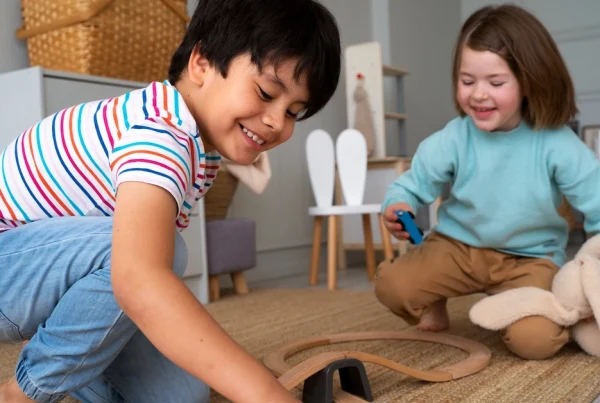Neuroplasticity, the brain’s remarkable ability to reorganize and form new connections, is especially active during early childhood. This period offers a critical window for learning and development, as the brain—particularly the cortex, which is responsible for higher cognitive functions—is highly adaptable and receptive to new experiences.
Neuroscience research shows that neurons, the building blocks of the brain, continuously form new pathways as children engage with their environment. By fostering an environment rich in stimulation, parents and educators can enhance a child’s cognitive abilities, laying the groundwork for lifelong learning. Encouraging activities that promote problem-solving, creativity, and emotional intelligence taps into the brain’s plasticity, supporting its ongoing development.
Engaging children in diverse and meaningful interactions is essential to maximizing neuroplasticity during these formative years. From play-based learning to exposure to different languages and sensory experiences, each interaction strengthens various parts of the brain, including those responsible for memory, attention, and emotional regulation.
The cortex, along with other regions, benefits significantly from such stimulation. As these neural pathways develop, the brain’s capacity for learning increases. By understanding and nurturing brain plasticity, parents can help children develop a strong foundation for academic success, personal growth, and emotional well-being.
What is Neuroplasticity and Why is It Important?
Neuroplasticity also referred to as brain plasticity or neural plasticity, is the ability of the human brain to change its structure and function throughout life. This includes the formation of new neural connections, strengthening existing ones, and even reorganizing brain function following new experiences or brain injury.
This capacity is particularly crucial in early childhood, from birth to around six years old, because the brain is at its most flexible during these formative years. During this time, various brain regions, including the auditory cortex and visual cortex, are highly active. This allows for significant synaptic plasticity—the strengthening or weakening of synaptic connections between neurons in response to increased activity.
Thanks to this heightened plasticity, children can more easily absorb new information and develop essential cognitive processes such as attention, problem-solving, memory, and emotional regulation. This process is supported by brain-derived neurotrophic factor (BDNF), a key protein that helps support the growth and maintenance of neural networks and underlines plasticity mechanisms within the brain.
In addition to learning and development, neuroplasticity also plays a key role in recovery. After a brain injury or trauma, the brain can engage in functional plasticity—redirecting functions from damaged areas to healthier regions, which helps restore capabilities. This remarkable ability showcases how adaptable and resilient our brains can be.
Furthermore, activities like physical exercise have been shown to boost brain connectivity and enhance both neurogenesis (the formation of new neurons, especially in the hippocampus) and plasticity. These benefits are not limited to childhood—adults also experience gains in mental clarity, memory, and mood regulation due to ongoing plastic changes in the brain.
In summary, neuroplasticity is foundational for how we learn, adapt, and recover. It is what enables children to acquire language, form healthy relationships, and navigate new environments—and it’s also what helps us continue growing throughout our lives.
Read Also: Life Skills for Early Childhood Development that Every Parent Should Know
How Neuroplasticity Impacts Learning in Early Childhood Education (ECE)
Early childhood education (ECE) offers a unique opportunity for brain development. During these years, a child’s brain is incredibly receptive to new information, experiences, and stimuli, forming new neural pathways with every interaction. The early childhood period is often called the “window of opportunity” because the brain’s ability to learn and grow is at its peak, thanks to the dynamic nature of synaptic connections.
Research shows that the experiences children have in their early years significantly impact brain structure and function, influencing how cognition develops over time. ECE provides a nurturing and stimulating environment where the brain can thrive, laying the foundation for lifelong learning and cognitive growth.
Engaging in diverse activities strengthens existing connections between neurons and fosters the development of new ones, enabling children to build a robust cognitive framework. By understanding the importance of neuroplasticity and its impact on learning, educators, and caregivers can create enriching experiences that support healthy brain development, encouraging children to reach their full potential.
 9 Ways to Support Neuroplasticity in Early Childhood Learning
9 Ways to Support Neuroplasticity in Early Childhood Learning
Parents and educators can support neuroplasticity and brain development in several effective ways to help children reach their full potential during these critical years. Here are six key strategies to enhance learning in early childhood.
1. Creating a Stimulating Learning Environment
A sensory-rich environment is essential for boosting neural activity and laying a strong foundation for learning. Exposure to diverse sensory stimulation—colors, sounds, textures, and movement—activates multiple brain regions and enhances functional connectivity, especially in the cerebral cortex.
These experiences support dendritic growth and new neural pathways, which are critical for acquiring knowledge. They also play a role in synaptic pruning, a process where unused connections are eliminated and active ones are strengthened, refining the brain’s efficiency.
2. Encouraging Play-Based Learning
Play is more than fun—it’s a primary driver of brain changes in children. Through creative and interactive play, the brain adapts, forms new connections, and practices key cognitive functions like attention, memory, and language.
Engaging activities like storytelling, pretend play, and games, enhance neural plasticity. For instance, in cases of monocular deprivation (loss of input from one eye), play and targeted exercises have been shown to help the brain compensate and rewire. These insights, backed by structural MRI studies, illustrate how play can shape the developing brain even in challenging conditions.
At SPH, we integrate play-based learning into our international preschool curriculum to provide children with hands-on experiences encouraging exploration and discovery. Our program allows students to learn through play, fostering their curiosity and creativity while cultivating essential life skills like communication, collaboration, and critical thinking in a supportive and stimulating environment. By understanding how play influences brain development, we create a dynamic learning atmosphere that nurtures every child’s potential.
Read Also: Benefits of Play-based Learning for Children
3. Integrating Physical Activity
Movement is a proven way to promote neuroplasticity. Physical activity improves blood flow and oxygen to the brain, boosting brain function and the release of brain-derived neurotrophic factor (BDNF)—a key protein that supports dendritic growth, neurogenesis, and the survival of neurons.
Activities like jumping, climbing, and dancing also strengthen functional connectivity, especially in areas tied to motor control and executive functioning. Even in older adults, regular physical activity is linked to a slower rate of cognitive decline and better memory retention.
4. Promoting Problem-Solving and Critical Thinking
Providing children with activities that challenge their thinking—such as puzzles, building blocks, or group problem-solving games—helps develop new neural pathways in the brain. These activities improve critical thinking skills and foster creativity.
Our early childhood education (ECE) program integrates STEAM (Science, Technology, Engineering, Arts, and Mathematics) into daily classroom activities, encouraging children to think critically, experiment, and solve problems in a hands-on, inquiry-based environment. Through STEAM projects, students learn to approach challenges creatively and analytically, building a strong foundation for future learning.
5. Encouraging Artistic and Creative Expression
Art, music, and other forms of creative expression are powerful tools for brain development. These activities stimulate both the right and left hemispheres of the brain, promoting better communication between them and enhancing overall cognitive function. Engaging in artistic endeavors fosters creativity and critical thinking, leading to significant changes in the brain that bolster learning and memory.
The brain has an incredible capacity for growth, and experiences that incorporate artistic expression can facilitate neural development, enriching a child’s cognitive landscape. By providing opportunities for creative exploration, we help children harness their creativity while strengthening their nervous system and overall cognitive abilities.
6. Cultivating Emotional Security and Attachment
A loving and secure environment is essential for healthy brain development. When children feel safe and nurtured, their brains can better focus on learning and growing. Emotional security also strengthens the brain’s ability to regulate stress, a critical factor in mental health.
The importance of qualified and caring teachers in fostering emotional security cannot be overstated. Our educators are highly trained and deeply committed to nurturing each child’s emotional and academic growth.
They create a supportive, trusting atmosphere where students feel valued, enabling them to thrive. Parents can feel confident knowing that at SPH, their children are guided by compassionate teachers who prioritize their well-being.
Read Also: Tips on How to Prevent Tech Addiction in Children
7. Supporting Language Learning and Verbal Interaction
Engaging children in rich verbal interactions—such as reading aloud, singing, and conversation—supports neuroplasticity by stimulating areas like the auditory cortex and cerebral cortex. These activities promote synaptic plasticity and help build essential language and communication skills.
Early language learning enhances not only vocabulary and memory but also social understanding and academic readiness by strengthening brain connectivity and fostering meaningful neural growth in the developing human brain.
8. Building a Growth Mindset and Encouraging Resilience
Teaching children a growth mindset—the belief that abilities can improve through effort—encourages the brain to adapt, strengthen, and form new connections. This mindset supports neural plasticity and improves a child’s ability to take on challenges with confidence.
Children who are encouraged to learn from mistakes and persist despite difficulties show improved cognitive processes such as problem-solving, decision-making, and emotional regulation, helping their brain function evolve over time.
9. Leveraging Community and Social Connections
Positive relationships within families, classrooms, and small groups greatly contribute to brain development by enhancing functional connectivity and emotional intelligence. Through collaborative play, peer interaction, and shared learning experiences, children activate multiple brain regions, promoting empathy, communication, and social awareness.
These meaningful connections also support the brain in handling stress, recovering from brain damage, and building resilience, making social engagement a powerful tool to promote neuroplasticity throughout early development and beyond.
Biblical Insights on Nurturing Neuroplasticity in Early Childhood
Throughout the Bible, we find principles that reflect the importance of nurturing children holistically. The wonders of God’s creation inspire curiosity and learning, as described in Psalm 139:14, where we are reminded of the marvelous works of God. Play and joy are also celebrated in Ecclesiastes 3:1-8, which reminds us that there is a time for everything, including play, as an essential part of childhood.
Physical activity aligns with the biblical principle of treating our bodies as temples (1 Corinthians 6:19-20), emphasizing the importance of caring for both body and mind. Encouraging critical thinking and wisdom ties into Proverbs 2:6, which says that “the Lord gives wisdom, and from His mouth come knowledge and understanding.”
Finally, creating a loving and secure environment models God’s unconditional love, as noted in 1 John 4:19: “We love because He first loved us.”
Conclusion
The early years of childhood are a time of remarkable growth and potential. By supporting neuroplasticity through play, creativity, physical activity, and a loving environment, parents and educators can lay the foundation for lifelong learning. These approaches, grounded in biblical principles, remind us that nurturing a child’s mind, body, and spirit is essential to their holistic development.
At SPH, we believe that the first few years of a child’s life represent a critical period of development that forms the foundation of their future. That is why our early childhood education programs are designed to nurture curiosity, foster creativity, and support holistic growth, ensuring that every child is set on the path to lifelong success.
Contact us today to learn more about how our international preschool program can help your child thrive in these crucial early years!








